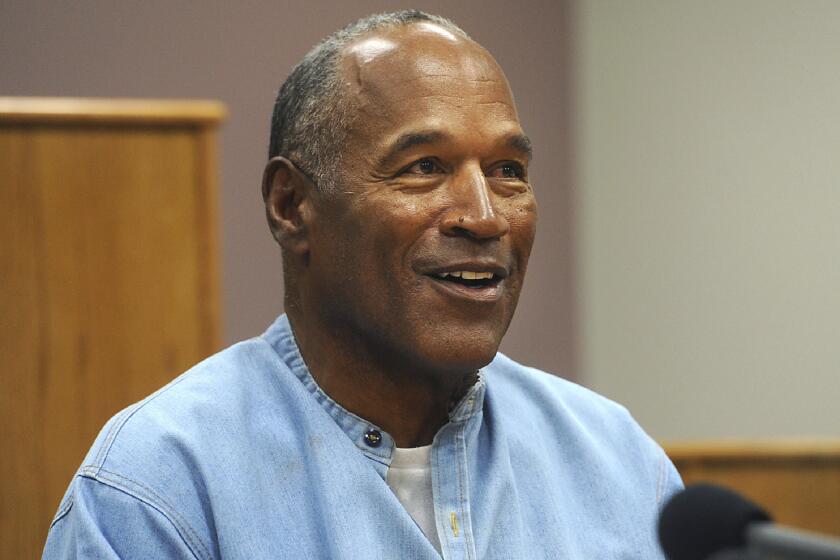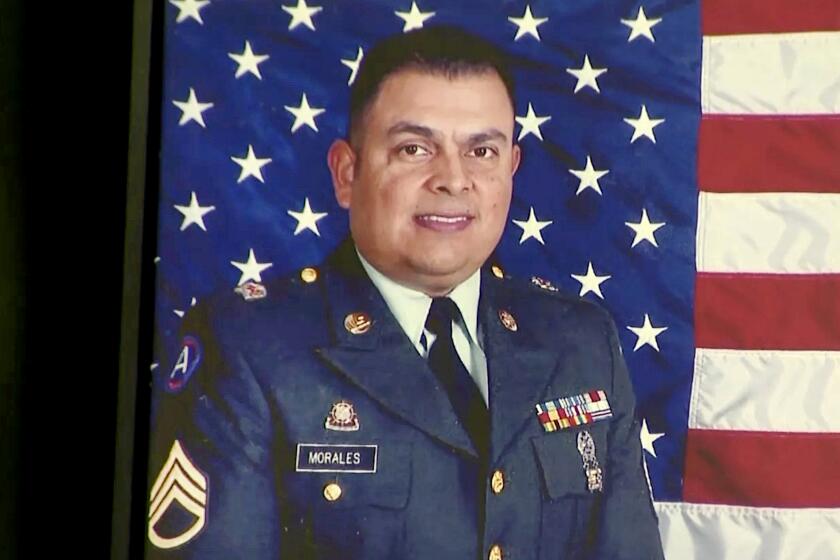Crackdown on pimps fuels a rise in human trafficking charges in L.A. County

For a long time, law enforcement drew little distinction between prostitutes and pimps.
But that’s rapidly changing.
Over the last few years, Los Angeles County prosecutors have been targeting pimps with human trafficking charges that can carry significantly greater punishment than pandering.
In 2014, the district attorney’s office filed human trafficking charges against 81 people — up from 25 in 2013 and 18 in 2012, according to a Times analysis of the office’s data. The office charged 40 people during the first six months of this year, the data show. Although forced-labor cases are also charged as human trafficking, the office said all but a few of the new cases targeted alleged pimps.
The steady uptick began after voters passed Proposition 35 in 2012, stiffening sentences and making the cases easier to prosecute, said Deputy Dist. Atty. Jane Creighton, coordinator of the office’s human trafficking unit, which was created in July 2014.
The shift is part of a larger sea change among law enforcement officials, who increasingly view women and children involved in prostitution as victims, not criminals.
The district attorney’s office started a program last year to divert teens arrested on prostitution charges out of the judicial system and into tutoring and therapy.
Last week, Los Angeles County Sheriff Jim McDonnell announced the creation of a task force to provide relief to victims of human trafficking. He’s also ordered his deputies to stop arresting children on prostitution charges and this month the district attorney’s office and board of supervisors held a summit focused on ending human trafficking statewide.
“The crime is still against the law,” Creighton said, “but obviously we do everything we can to treat them as victims.”
Human trafficking cases are inherently hard to prosecute, Creighton said, because the victims — whose testimony is crucial for a conviction — are often reluctant witnesses. Some change their accounts when on the witness stand, fearful of retaliation. Others refuse to cooperate from the start after years of being warned against working with authorities by their pimps and because they often still feel allegiance toward them.
Perceptions of prostitutes and pimps have evolved through the years.
In 1887, The Times covered a “crusade against prostitutes” in San Bernardino, during which women arrested for the crime had to pay $500 or spend six months in jail. And in the early 1980s, when LAPD officers did a big prostitution bust in Hollywood, 137 people were arrested — only three of them men accused of pimping. During a news conference in January, Dist. Atty. Jackie Lacey said that, for years, popular culture shaped how people viewed the crime.
“In Hollywood, the term ‘pimp’ has been glamorized,” she said. “There are movies about pimps, showing them as benevolent. We have really changed our thinking on that.”
The increase in charges filed in Los Angeles County falls in line with a national movement toward cracking down on pimps as the perpetrators of human trafficking, said Amy Farrell, a human trafficking researcher who teaches criminology at Northeastern University.
“This is a decided change we’ve seen around the country,” Farrell said.
Lois Lee, executive director of Van Nuys nonprofit Children of the Night, an organization dedicated to “rescuing America’s children from prostitution,” said talk of heightened focus on investigating and prosecuting pimps sounds mainly like bravado to her. Despite a shift in rhetoric in referring to girls as victims, not criminals, Lee said many are still housed in juvenile hall.
“There’s this whole hoopla,” she said. “We got this bill, we got this and that. Where are the children? Where is the child living?”
On a recent afternoon, five teenage girls sat in the school room at Children of the Night. When Lee asked them about their former pimps, one girl scowled and another, an 18-year-old from Colorado, opened her big brown eyes wide. While she was initially hesitant to testify against her pimp, who had been trafficking her since she was 12, she said she eventually realized that she was a pawn in his game and cooperated with prosecutors.
“If he doesn’t care about me,” she said, “I shouldn’t care about him.”
Another girl said she would never testify against her former pimp or madam: “I’m terrified,” she said, fidgeting with her brown hair.
Farrell, the researcher, said the increase in charges “doesn’t mean there’s more trafficking” in Los Angeles, saying instead it’s a sign of better communication between law enforcement and prosecutors about how to build strong cases against pimps.
“The police then know how to investigate these cases to make them stick,” she said.
But it’s not always easy.
On a Saturday night this year in South L.A., Los Angeles Police Lt. Andre Dawson patrolled the city’s prostitution “tracks.” He pulled up in a car outside a liquor store and watched a man in a gray sweatsuit sitting in a parked, pearl-white Cadillac. The man stared at two girls — at least one of whom looked younger than 18 — as they approached another car with a man inside.
Dawson said he was pretty sure the man eyeing the girls from afar was their pimp. He called for backup.
“Where are you?” he said into his cellphone. “I got some minors over here and the pimp is on the corner.”
The man in the sweatsuit spotted Dawson and sped off, but another man in a green shirt — the “lookout guy” or “pimp partner,” Dawson said — stood outside the liquor store. He snapped pictures of Dawson’s sport utility vehicle with his cellphone — a move Dawson, who retired this fall, said was designed to alert others in the area to the police presence.
Dawson looped around the block to avoid detection. When he returned, the young girl was gone.
“Dammit,” he said, sighing. “I hate that that little girl got away. Rats.”
Law enforcement stings have recently helped identify some pimps.
Last year, an undercover Long Beach Police Department detective knocked on the door of a hotel room, answering an ad he’d found on the classified advertising website Backpage.
A 16-year-old girl answered the door, but there was an older woman in the room too. They discussed prices for various sex acts and the detective put $360 on the dresser.
The teenager picked up the money and tucked it away. The older woman encouraged her: “Smart girl, smart girl.”
Before long, other officers rushed into the room and the detective interviewed the teenager, who identified her pimp for him, according to court records.
During a preliminary hearing in a Long Beach courtroom, a detective testified that soon after officers arrested Eric Avery on pimping and trafficking charges he spoke with a teenage girl who said she’d worked for Avery for two months. She told him that she was required to earn “a rack” — $1,000 — every night.
But during Avery’s preliminary hearing, the girl was evasive. She said that she didn’t really work for him.
“I do me, and he will do him,” she said. “That was the arrangement.”
When a prosecutor asked her to point to Avery, she said she didn’t want to.
“Do you want to be here today?” the prosecutor asked.
“Nope,” the girl said.
“Why not?” the prosecutor responded.
The girl shot back: “Because I don’t.”
Last year, a jury convicted Avery, 26, of pimping and trafficking a minor. He is serving 33 years in prison. His alleged partner, Lebrette Winn, 24, is serving a 47-years-to-life prison sentence for pimping, pandering, rape, kidnapping and other charges.
During Winn’s preliminary hearing, a 21-year-old woman took the stand. She had Winn’s pimp moniker, prosecutors say, tattooed across her forehead. Winn forced her to get the ink, prosecutors say, as punishment for wanting to escape.
The woman told a judge that she met Winn at a parade in January 2013. Things weren’t going well at home and she needed money. He promised her work babysitting his daughter, but instead gave her a pair of high heels and convinced her to work as a prostitute. He always kept the money she made, which she said upset her.
One morning, after his stepmom left, he raped her, she testified. After she attempted to escape, he made her kneel on raw macaroni for two hours as punishment. Another time, she said, he made her bathe in ice.
She managed to escape from his car in a parking lot, prosecutors say, and found a good Samaritan who drove her to a police station.
At Winn’s sentencing, a judge told him that he couldn’t stop thinking about the tattoo on the woman’s forehead.
“People being branded like cattle,” the judge said. “Very, very cruel.”
Twitter: @marisagerber
ALSO
Poland won’t extradite Roman Polanski to the U.S.
Decades later, Dave’s still not here: A conversation with Tommy Chong
Theft of wheelchair from girl without legs met with outpouring of support
More to Read
Start your day right
Sign up for Essential California for news, features and recommendations from the L.A. Times and beyond in your inbox six days a week.
You may occasionally receive promotional content from the Los Angeles Times.







